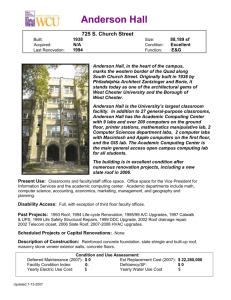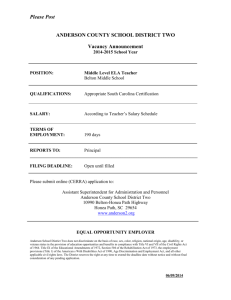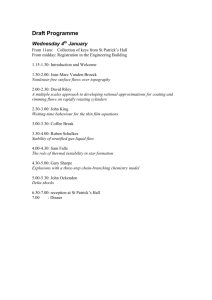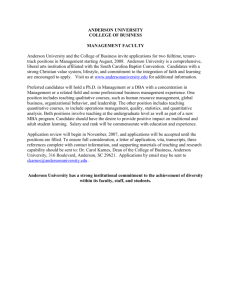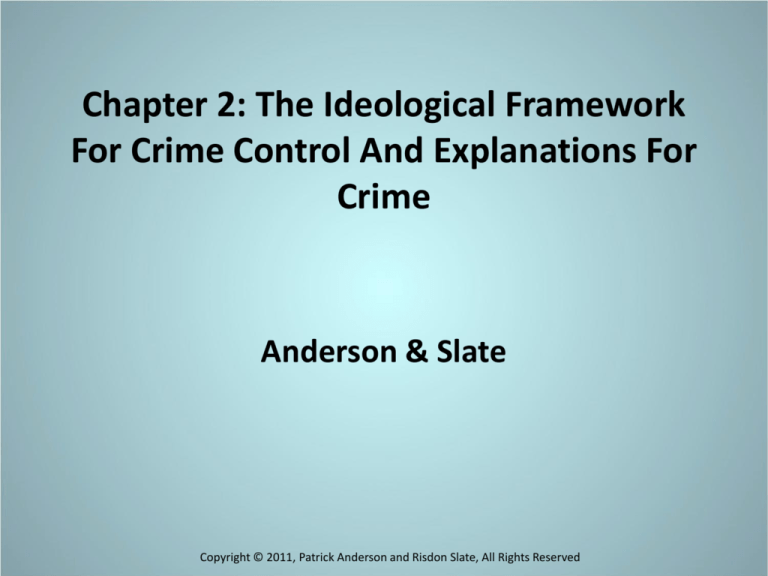
Chapter 2: The Ideological Framework
For Crime Control And Explanations For
Crime
Anderson & Slate
Copyright © 2011, Patrick Anderson and Risdon Slate, All Rights Reserved
Models of Criminal Justice
Conservative Crime Control
Model
•
•
•
•
•
•
•
•
•
•
“Get tough on crime”
“Lock ‘em up”
“Unleash cops & prosecutors”
Criminal sanctions resemble
parental discipline
Abolish “loopholes” in criminal
justice
Assembly-line justice
Punishment-deterrence
Quick, efficient processing of
guilty persons
Presumption of guilt
Factual Guilt
Liberal Due Process Model
• Criminal justice resembles a
classroom
• Emphasis on causes of crime
• Due process of law
• Criminal justice should be an
obstacle course, erect hurdles
• Quality, not quantity, of arrests
and convictions
• Control the police and
prosecutors
• Individual rights
• Legal guilt
Copyright © 2011, Patrick Anderson and Risdon Slate, All Rights Reserved
Conservative Crime Control Model
Most important functions of criminal justice
include:
Repression of criminal conduct
High rate of apprehension and conviction
Speed and finality of criminal justice processing
Finality is created by minimizing the occasions for
challenging or derailing the criminal justice
process.
Copyright © 2011, Patrick Anderson and Risdon Slate, All Rights Reserved
Samuel Walker
• Why does he refer to it as liberal and
conservative theology?
• What does Walker say about the death
penalty as a general deterrent?
Copyright © 2011, Patrick Anderson and Risdon Slate, All Rights Reserved
In the adult system, it is called arraignment; in the juvenile, it is
called a detention hearing.
In the adult system, there is a right to a jury trial; in the juvenile,
there is no right to a jury trial.
In the adult system, it is called, trial; in the juvenile, it is called an
adjudicatory hearing.
In the adult system, one is found guilty; in the juvenile, one is
adjudicated delinquent.
In the adult system, it is called a sentencing hearing; in the juvenile, it
is called a dispositional hearing.
In the adult system, it is called a presentence report; in the juvenile, a
pre-dispositional report.
In the adult system, one is sent to prison; in the juvenile system, one
is sent to a state training school.
Copyright © 2011, Patrick Anderson and Risdon Slate, All Rights Reserved
Mckeiver v. Pennsylvania
• Juveniles and Jury Trials
Copyright © 2011, Patrick Anderson and Risdon Slate, All Rights Reserved
Classical Criminology
• According to the classical school of
criminology all behavior is a product of
the individual’s free will.
1738-1794
Age of
Enlightenment
Cesare
Beccaria
On Crimes
and
Punishment
• As a result of the belief that the people
being governed have to be in agreement with
the control of their government:
“ government by the consent of the governed ”
Copyright © 2011, Patrick Anderson and Risdon Slate, All Rights Reserved
Considerations
• Classical Criminology does take into
consideration those who do not have
“free will” to make decisions
-the young, the insane
and the incapacitated
• For such individuals, treatment is
thought to be more appropriate than
punishment.
• Those who do commit criminal acts out
of their own “free will” are to be
punished quickly and justly.
Copyright © 2011, Patrick Anderson and Risdon Slate, All Rights Reserved
FREE WILL!
K
Neoclassical School
there is free will, but…
• sometimes circumstances
that may negate or lessen
someone’s responsibility for
the commission of an act
may exist.
• not all behavior is based on
rational choice
• Insanity and coercion
could cause the
commission of crime.
Copyright © 2011, Patrick Anderson and Risdon Slate, All Rights Reserved
Positive Criminology
• Believes people are naturally social,
conforming individuals
• Takes environment into consideration
when attempting to explain crime
• Therefore:
– Criminal behavior is abnormal or
pathological
• Detectible and curable
Copyright © 2011, Patrick Anderson and Risdon Slate, All Rights Reserved
The Positive School of Criminology
• Positive Criminologist study biological,
psychological, and sociological factors that
contribute to criminal behavior.
Today we use several methods to identify crime as an
attempt to capture criminals so that they can be dealt
with accordingly.
• Education programs (Junior Police)
• Neighborhood watch
• Surveillance (shopping center, bank etc.)
Copyright © 2011, Patrick Anderson and Risdon Slate, All Rights Reserved
Continuum on Responsibility
Classical School
Neoclassical School
Positive School
Free Will
Soft Determinism
Hard
Determinism
Fully Responsible
Responsibility mitigated by circumstances
Not Responsible
Copyright © 2011, Patrick Anderson and Risdon Slate, All Rights Reserved
Biological Determinism
Cesare Lombroso: “father of modern criminology”
Believed criminals were not as evolved as non criminals
Criminals were characterized by animal like, amoral
behavior
Atavistic: throwbacks to a more primitive stage of
development
Copyright © 2011, Patrick Anderson and Risdon Slate, All Rights Reserved
Focus of Biological Determinism
• Biological Determinism theories
focus on studies of stigmata, or
body types, genes and
chromosomes as well as
differences in brain or central
nervous system
Classical
Cesare
Free
Cesare
Criminology
Beccaria
will
Lombroso
Atavistic
Copyright © 2011, Patrick Anderson and Risdon Slate, All Rights Reserved
Biological
Determinism
Phrenology
• Phrenology: “lumps on
head” theory
In Europe:
Francis Gall developed a system to show the relationship
between head shapes or knobs, and behavior and
character traits
In America:
Charles Caldwell reported three
compartments in the brain
One for active propensities, one for
moral sentiment, and one for
intellectual faculties
Copyright © 2011, Patrick Anderson and Risdon Slate, All Rights Reserved
Body Types and Crime
•
William Sheldon studied
delinquent boys in Boston
and classified body types as:
– Endomorph: rotund and jovial
with outgoing personalities
– Mesomorph: muscular, well
proportioned, with competitive,
aggressive, and driven
personalities
– Ectomorph: slender and frail,
introverted, withdrawn
behaviors
Copyright © 2011, Patrick Anderson and Risdon Slate, All Rights Reserved
Exploring Genetic Influences
• Studies of prisoners revealed that a
statistically significant number of prisoners
had an XYY chromosome abnormality.
– Supermale: more aggressive and potentially
criminal individuals with an extra Y chromosome
– XYY male: said to be 6 inches taller than the
average male with a lower IQ
BUT
Further research showed that the XYY male was
less aggressive and less likely to commit crimes
against persons than the XY male
Copyright © 2011, Patrick Anderson and Risdon Slate, All Rights Reserved
DNA and Crime
• Genetic influences on crime are still being researched, but the
advances in technology have allowed for the identification of
and individual through hair and skin cells amongst other things
that contain DNA.
• This has not only assisted in identifying the criminal but also in
identifying the victim in cases of severe disfiguration and lack
of identification.
• Unfortunately, areas such as forensic science have grown in
popularity and have become the focus of several television
shows.
– The oversimplified plots that take place on television result in the
jury’s increased expectations when it comes to the evidence found
at the scene of a crime.
– As a result, experts have to testify explaining why the evidence is
not there in order to satisfy the jury’s expectations.
– This increases the length of the trial process and therefore,
increases court costs.
Copyright © 2011, Patrick Anderson and Risdon Slate, All Rights Reserved
Contemporary Biological Research
• Today heredity is the generally accepted causative factor in things
such as:
–
–
–
–
Alcoholism
Cancer
Heart disease
Violent behavior
Nutrition and early childhood
effect behavior patterns for years
after their actual occurrence.
C. Ray Jeffery: leading proponent of genes influencing behavior through
brain chemistry, hormonal systems and their interaction with
environment
Copyright © 2011, Patrick Anderson and Risdon Slate, All Rights Reserved
Psychological Explanation of Crime
• Psychological theories about crime have focused on
intelligence, personality disorders, and insanity.
Alfred Binet: used task-related skills that measured
reasoning ability
– Intelligence Quotient (IQ): mental age divided by chronological age
and multiplying by 100
– Binet-Simon scale: tasks arranged from 54-90 that covered mental
ages from three years to what is called the
“superior adult”
Copyright © 2011, Patrick Anderson and Risdon Slate, All Rights Reserved

